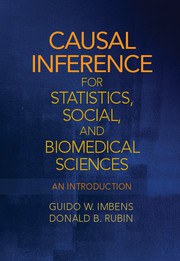Causal Inference in Statistics, Social, and Biomedical Sciences
Douban
An Introduction
Guido W. Imbens / Donald B. Rubin
Sinossi
Most questions in social and biomedical sciences are causal in nature: what would happen to individuals, or to groups, if part of their environment were changed? In this groundbreaking text, two world-renowned experts present statistical methods for studying such questions. This book starts with the notion of potential outcomes, each corresponding to the outcome that would be realized if a subject were exposed to a particular treatment or regime. In this approach, causal effects are comparisons of such potential outcomes. The fundamental problem of causal inference is that we can only observe one of the potential outcomes for a particular subject. The authors discuss how randomized experiments allow us to assess causal effects and then turn to observational studies. They lay out the assumptions needed for causal inference and describe the leading analysis methods, including, matching, propensity-score methods, and instrumental variables. Many detailed applications are included, with special focus on practical aspects for the empirical researcher.
contents
Part I. Introduction:
1. The basic framework: potential outcomes, stability, and the assignment mechanism
2. A brief history of the potential-outcome approach to causal inference
3. A taxonomy of assignment mechanisms
Part II. Classical Randomized Experiments:
4. A taxonomy of classical randomized experiments
5. Fisher's exact P-values for completely randomized experiments
6. Neyman's repeated sampling approach to completely randomized experiments
7. Regression methods for completely randomized experiments
8. Model-based inference in completely randomized experiments
9. Stratified randomized experiments
10. Paired randomized experiments
11. Case study: an experimental evaluation of a labor-market program
Part III. Regular Assignment Mechanisms: Design:
12. Unconfounded treatment assignment
13. Estimating the propensity score
14. Assessing overlap in covariate distributions
15. Design in observational studies: matching to ensure balance in covariate distributions
16. Design in observational studies: trimming to ensure balance in covariate distributions
Part IV. Regular Assignment Mechanisms: Analysis:
17. Subclassification on the propensity score
18. Matching estimators (Card-Krueger data)
19. Estimating the variance of estimators under unconfoundedness
20. Alternative estimands
Part V. Regular Assignment Mechanisms: Supplementary Analyses:
21. Assessing the unconfoundedness assumption
22. Sensitivity analysis and bounds
Part VI. Regular Assignment Mechanisms with Noncompliance: Analysis:
23. Instrumental-variables analysis of randomized experiments with one-sided noncompliance
24. Instrumental-variables analysis of randomized experiments with two-sided noncompliance
25. Model-based analyses with instrumental variables
Part VII. Conclusion:
26. Conclusions and extensions.